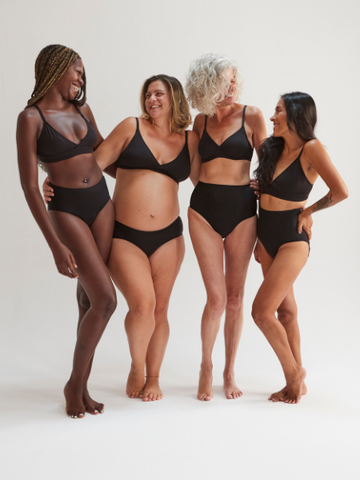Managing Stress Incontinence
Ever leaked a little when you laugh, cough or sneeze? You’re probably not alone, but chances are not many of your friends will admit it if you asked them. The reality is though, that stress incontinence actuality affects millions of people across the globe, and according to the Continence Foundation of Austrlia, around 1 in 4 Australians experience it to some extent, 80% are women and half of these women are under 50 years old.
We’ve decided to tackle this taboo head on, with a deeper dive into what exactly stress incontinence is, what causes it and what we can do to manage it safely.
WHAT IS STRESS INCONTINENCE AND WHAT CAUSES IT?Urinary incontinence is the loss of bladder control. Stress incontinence happens when movement or activity puts pressure on the bladder, causing urine to leak. Movements include coughing, laughing, sneezing, running or heavy lifting. Stress incontinence is not related to mental stress.
Stress incontinence is not the same as urgency incontinence and overactive bladder (OAB). Those conditions cause the bladder muscle to spasm. This leads to a sudden need to urinate quickly. Stress incontinence is much more common in women than in men.
Most of us have been there, but why exactly does this happen?
Stress incontinence happens when certain muscles and other tissues linked to urinating weaken. These include the muscles that support the urethra, called the pelvic floor muscles, and the muscles that control the release of urine, called the urinary sphincter.
The bladder expands as it fills with urine. Most often, valve-like muscles in the tube that carries urine out of the body, called the urethra, stay closed as the bladder expands. This keeps you from leaking urine until you reach a bathroom.
But when those muscles weaken, anything that puts force on the stomach and pelvic muscles put pressure on your bladder. Sneezing, bending over, lifting or laughing hard, for instance, can cause urine leakage.

TREATING STRESS INCONTINENCE
We understand the sensitivity of incontinence. It's important to openly discuss this topic without embarrassment. Remember, seeking medical advice is always a good option.
Consider the severity of urine leakage, duration of the issue, and lack of improvement with pelvic physiotherapy. If a prolapse persists despite treatment, consult a doctor. Seek medical help if stress incontinence impacts your quality of life for proper management.
Keeping track of your symptoms and how often you experience urine leaks, how often you use the toilet, and how much fluid you drink daily can provide valuable insights for your doctor.
NON-SURGICAL TREATMENTS
Your doctor might suggest a range of at-home treatments to try, most of which can be easily implemented.
PELVIC FLOOR EXERCISES
Pelvic floor exercises are a great way to strengthen muscles and alleviate stress incontinence symptoms, while also preventing it from occurring. Everyone can benefit from incorporating pelvic floor exercises into their routine. You can use tools like yoni eggs to help support your practice, as they help you to focus your attention and also build strength with the weights.
Pelvic floor exercises can help strengthen the muscles and improve pelvic anatomy, aiding in bladder control and leakages. It's best to try them under the guidance of a trained physiotherapist.
There are some yoga poses which are particularly good for the pelvic floor- see this post for more information. And don’t forget a pair of our amazing Orgaknix Boyshorts to absorb your flow and to catch any sneezy leaks while you work out.

LIFESTYLE CHANGES
Being overweight can strain your pelvic floor muscles and lead to incontinence. Maintain a healthy diet, limit alcohol and processed foods. Consult your GP for safe weight loss methods and consider regular exercise for muscle tone.
We recommend Eco Period LBL underwear to help you manage light leaks and dribbles. You may like organic cotton and you can try our Orgaknix High Waist underwear, or if you prefer seamless styles the French Cut Invisi Seamless are fantastic and hold up to 40ml. These undies are soft and super comfy, helping to keep you dry and odour free.
Available in midi brief, high waist and g-string styles, Eco Period LBL incontinence underwear come in sizes 8 to 24 and a range of colours.
BLADDER TRAINING
Your GP might recommend bladder training, especially if you have urge incontinence. This occurs when you often feel a sudden urge to pee, sometimes associated with a UTI.
INCONTINENCE PANTS
Using Eco Period Incontinence underwear won’t cure the condition, but it can help manage it. They are comfortable and safe for everyone. These absorb leaks, keeping you dry and comfortable. Simply wash and re-use them for another day.

SURGICAL TREATMENTS
There are some surgical treatments that might be recommend by your doctor if non-surgical treatments aren’t successful.
- Colposuspension- a cut made to the lower abdomen, with the bladder neck lifted and stitched in place. Effective long-term incontinence solution.
- Sling surgery involves a cut in the lower abdomen and vagina with a sling placed around the bladder's neck for support, preventing leaks.
- Vaginal mesh surgery involves placing synthetic mesh behind the urethra for support. This is generally only recommended as a last resort for urgent cases.
- Injecting urethral bulking agents to increase the size of the urethra walls, aiding in better closure.
THE BOTTOM LINE ON STRESS INCONTINENCE
Stress incontinence can be caused by various factors, such as childbirth and aging. It is a common and normal issue that should not cause embarrassment. Consult your doctor if you have leaks when coughing, laughing, or sneezing- there are simple home remedies to help prevent it from worsening.
Never skip your pelvic floor exercises, and maintain a healthy diet with plenty of exercise. Oh, and if you do suffer the occasional leak (you’re definitely not alone!) make sure you have a pair of Eco Period Incontinence undies on hand, to absorb your flow and keep you comfy and dry.



